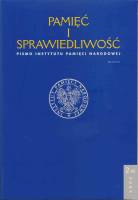Wybrane zagadnienia odpowiedzialności karnej za zbrodnie przeciw ludzkości określone w art. 3 ustawy o IPN
Chosen issues of amenability to law for crimes against humanity defined in article 3 of Act on Institute of National Remembrance
Author(s): Przemysław Piątek Subject(s): Law, Constitution, Jurisprudence
Published by: Instytut Pamięci Narodowej
Keywords: substantive law issues concerning crimes against humanity; the Prosecution of Crimes against the Polish Nation
Summary/Abstract: Author presents some of substantive law issues concerning crimes against humanity currently persecuted by Chief Commission for the Prosecution of Crimes against the Polish Nation of the Institute of National Remembrance. In the introductory part there are presented problems related to the virtues which led to introducing a regulation into the Act of 18 December 1998 on the Institute of National Remembrance – Commission for the Prosecution of Crimes against the Polish Nation (Journal of Laws, 19 December 1998), on the basis of which crimes against humanity, including both crimes of Nazi occupation and crimes committed in Stalin period, are currently persecuted. In the following part of the article issues which are vital for the correct interpretation and consequently for practical use of article 3 of Act on Institute of National Remembrance by the lawyers are explained. These issues are as follows: legal nature of the definition included in a regulation, elements which define the notion of crime against humanity, time of committing deeds recognized as crimes against humanity, relation to notions of crime and offence defined in the Criminal Code, interdependence between crimes against humanity and types of crimes defined in Polish criminal law, so called subject matters, especially intention to commit deeds recognized as crimes against humanity, subject of a crime, that is a person, who can be a perpetrator of a deed recognized as crime against humanity, the „mass character” of those deeds and a very important (especially for apprehended perpetrators) issue of so called intertemporal law. In the final part the author presents most often disclosed kinds of crimes recognized as crimes against humanity committed in 1939–1956 on the example of subjects of investigations by particular Branch Commissions for the Prosecution of Crimes against the Polish Nation.
Journal: Pamięć i Sprawiedliwość.
- Issue Year: 6/2004
- Issue No: 2
- Page Range: 247-278
- Page Count: 32
- Language: Polish

